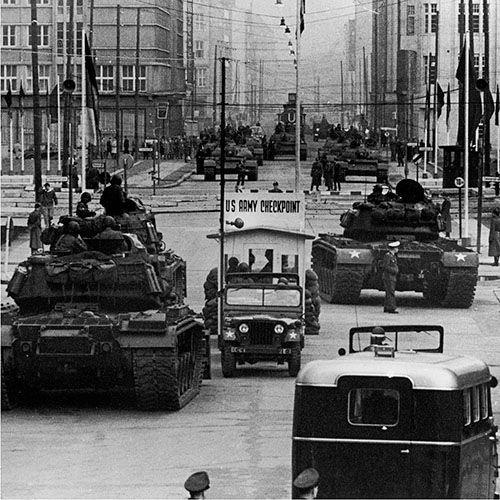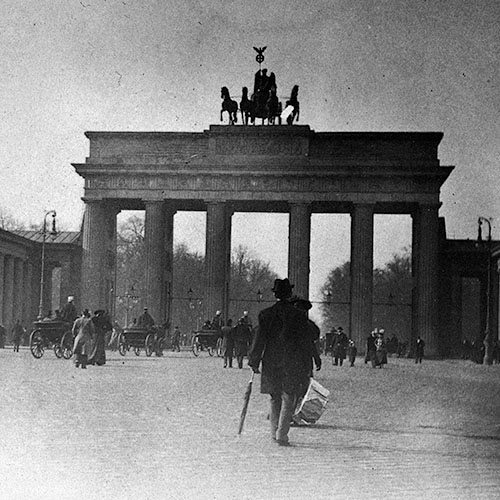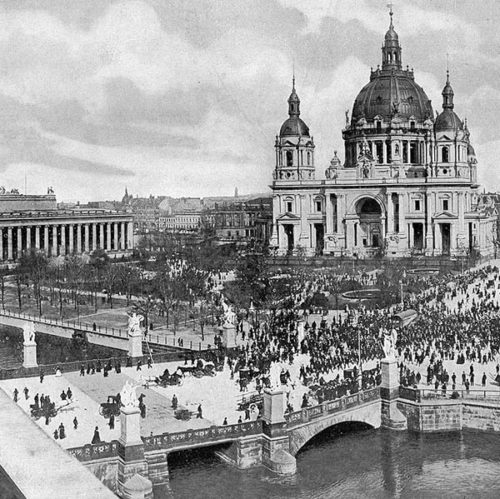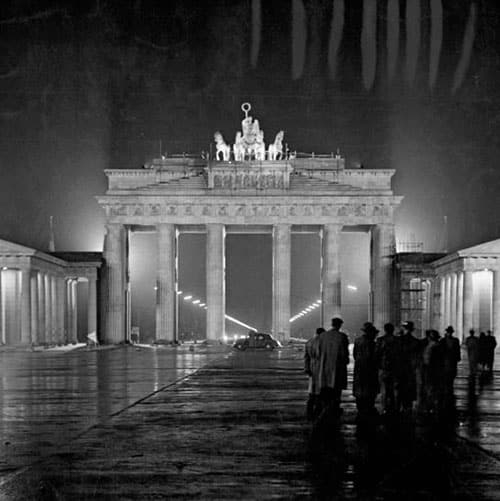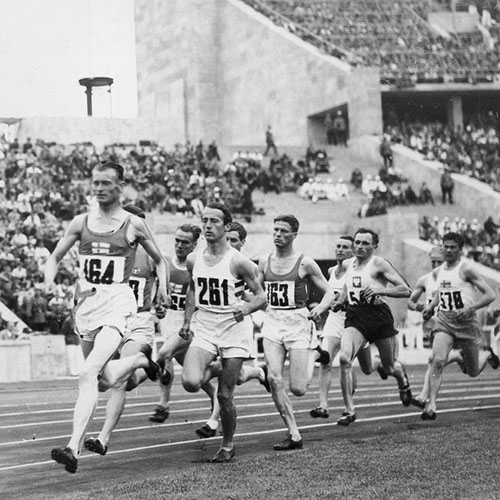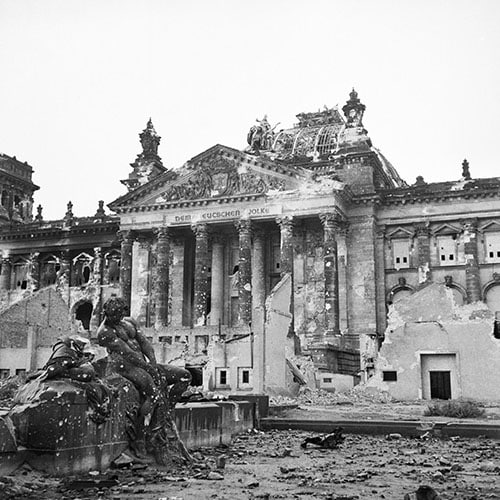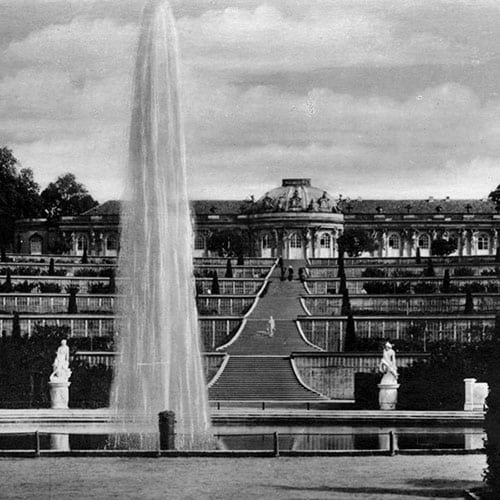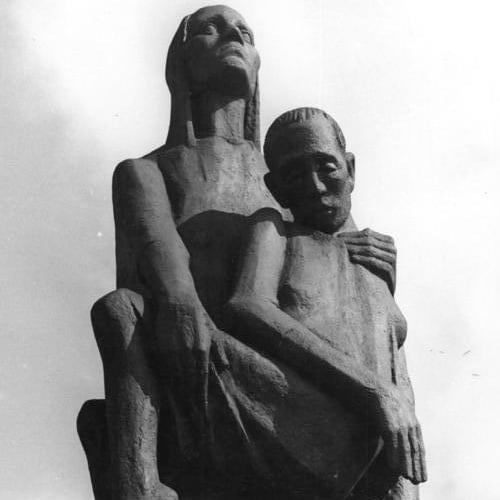“The Messalina of the North is dead. Morta la Bestia [The beast is dead].”
Frederick the Great, on hearing of the news of the death of the Russian Emperess, Elizabeth on January 22nd 1762
On April 12th 1945, US President Franklin D. Roosevelt – the four-term President – passed away from a massive cerebral hemorrhage.
The news would reach British Prime Minister Winston Churchill on the morning of Friday 13th, when as a result he would request that out of respect the House of Commons adjourned as a sign of respect to the man he would call a ‘shining personality’. It was the first time a foreign head of state was given such an honour.
The reaction in Berlin was not quite as solemn.
Nazi Propaganda Minister, Joseph Goebbels, had earlier commissioned an astrological study that had predicted troubling times coming in the early part of April, with relief later in the month. The death of Roosevelt was seen as the turning point that Goebbels and Hitler had been waiting for – and the sycophantic Goebbels was only eager to impress on his Führer the potential ramifications.
At the lowest point in the Seven Years War, Prussian King, Frederick the Great, had faced defeat at the hands of overwhelming odds and only been saved by the death of one of his foes – Russian Czarina Elizabeth.
What would become known as the ‘Miracle of the House of Brandenburg’.
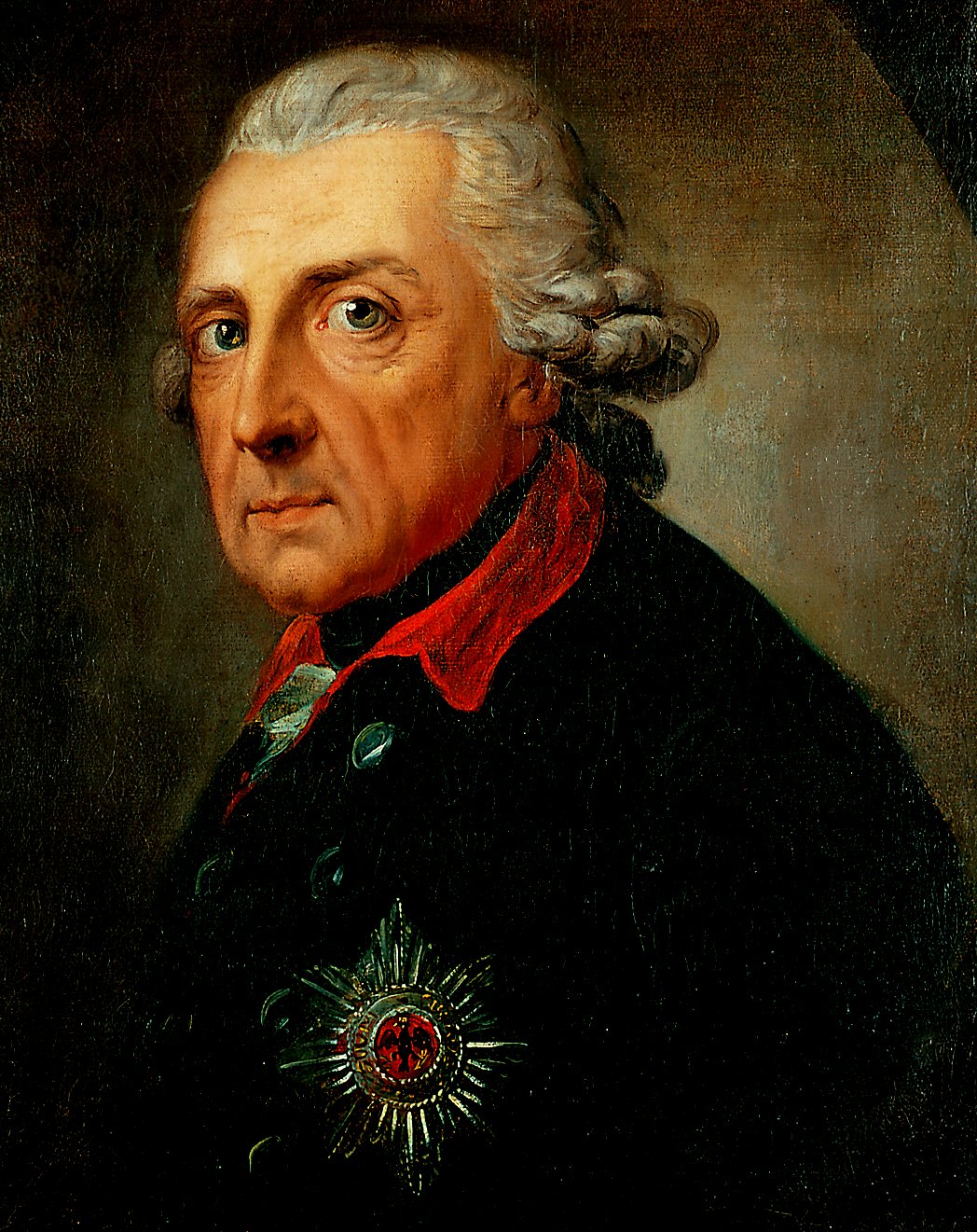
History, Goebbel would boast, was repeating itself.
The Russian horde would be repelled from the gates of Berlin, and the American forces could now change sides to fight alongside German forces to defeat the real enemy – international Bolshevism.
In the midst of this possible change of fortunes – the death of one man – the war, however, continued unabated. The ‘Miracle of the House of Hitler’ would amount to nothing.
Hardly had the world had time to notice that the day that Roosevelt shuffled off this mortal coil, US troops had finally reached and crossed the murky waters of the river Elbe – as units of the Ninth Army made it to Magdeburg, only fifty miles from Berlin.
It is here that the US forces would halt – at the Elbe – for the entire period of the Soviet Berlin Strategic Offensive Operation, the bloody battle for the Nazi capital.
–

Berlin Or Berchtesgaden
“What you’re proposing is this—if I give you all the supplies you want, you could go straight to Berlin—right straight (500 miles) to Berlin? Monty, you’re nuts. You can’t do it. What the hell[?] … If you try a long column like that in a single thrust you’d have to throw off division after division to protect your flanks from attack.”
General Dwight D. Eisenhower writing to British Field Marshal, Montgomery (1944)
By the spring of 1945, the Allied war machine that had landed on the beaches of Normandy less than a year prior had become an unstoppable juggernaut.
Having weathered Hitler’s final desperate gamble in the Ardennes, the Western Allies stood poised on the banks of the Rhine, the last significant natural barrier defending the heart of Germany.
Victory in Europe was no longer a question of if, but when, and how the final blows would fall.
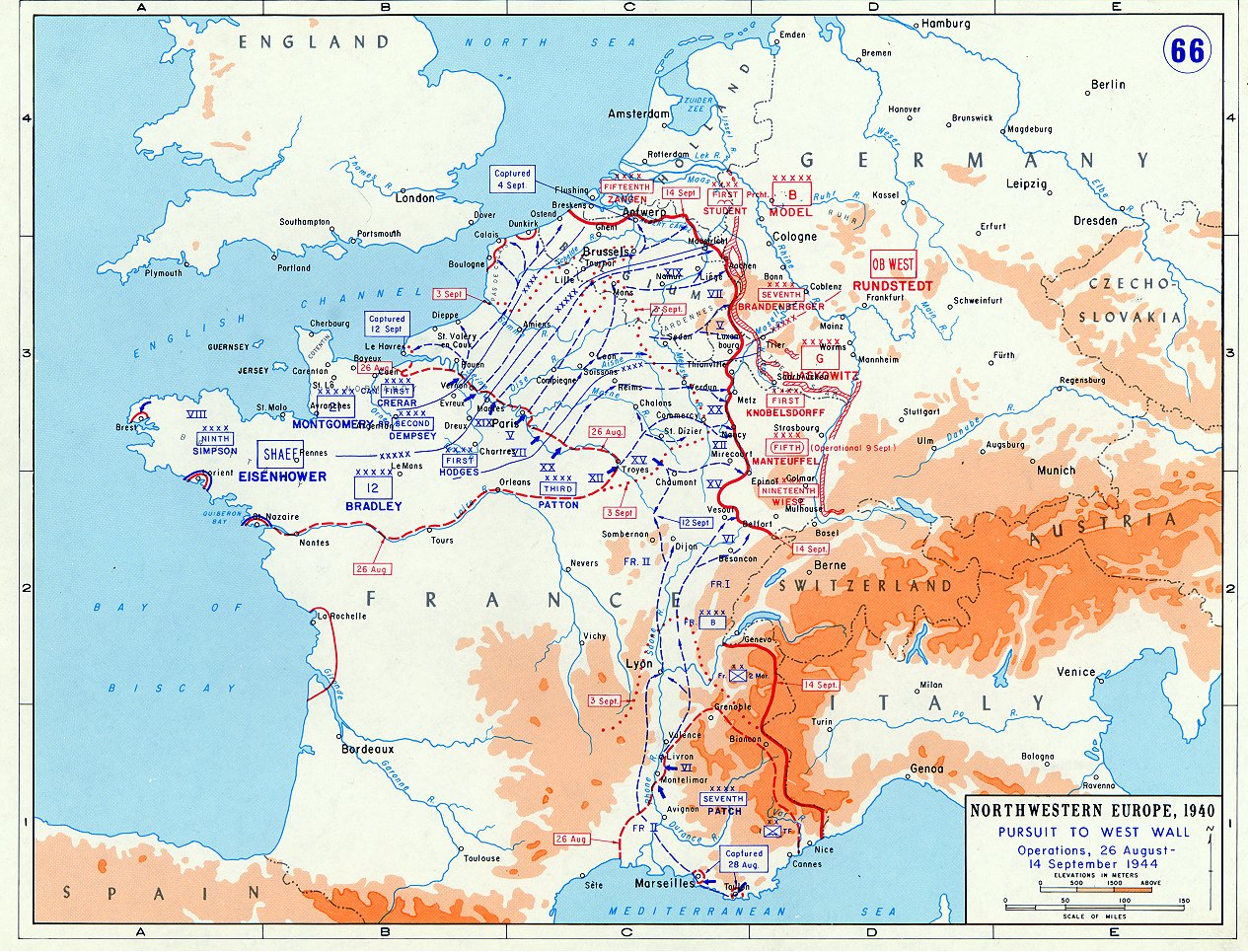
As the invasion of Germany commenced, Supreme Allied Commander Dwight D. Eisenhower commanded a formidable force of 90 full-strength divisions, including 25 powerful armored divisions, arrayed along a 450-mile front stretching from the North Sea to the Swiss border.
The strategic question was not one of strength, but of direction.
For British Prime Minister Winston Churchill, the answer was simple and politically charged: a rapid advance to “shake hands with the Russians as far east as possible,” with the ultimate prize being the capital of the Reich, Berlin.
Eisenhower’s initial strategy appeared to align with this thinking.
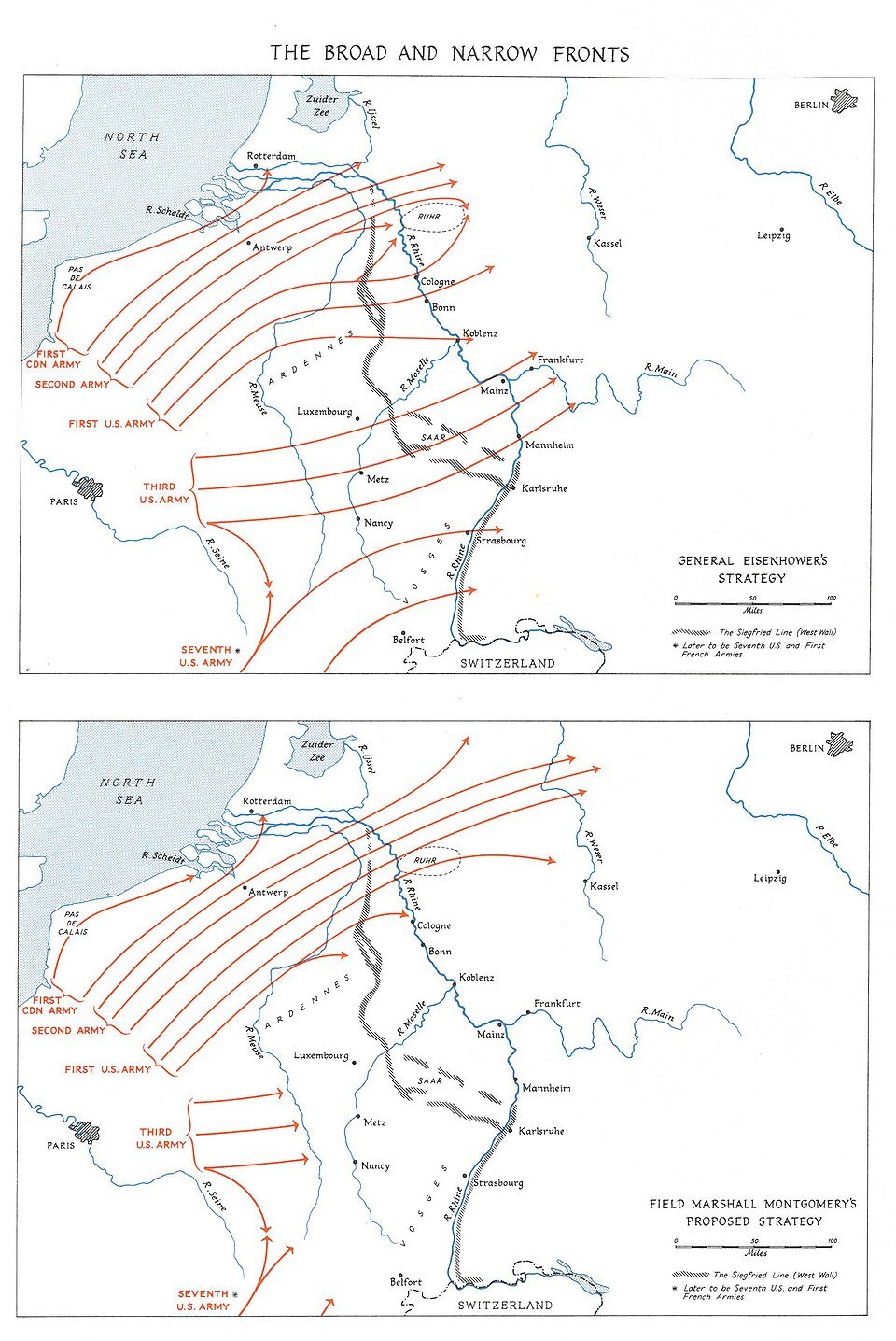
The operational plan conceived after crossing the Rhine designated Field Marshal Bernard Montgomery’s 21st Army Group, comprising British, Canadian, and American forces, as the main effort. This northern thrust would cross the open plains of northern Germany, the most direct, if not the easiest, route to Berlin. In support, the American 12th and 6th Army Groups under Generals Omar Bradley and Jacob Devers would launch subsidiary offensives to the south, designed to keep German forces off-balance and prevent them from concentrating against Montgomery’s main drive.
This strategy offered a degree of flexibility, but its primary objective was clear: the political and symbolic heart of Nazi Germany.
However, as March drew to a close, Eisenhower’s strategic calculus began to shift, influenced by battlefield realities and troubling intelligence reports.
The most immediate factor was the position of the Red Army.

Soviet forces, in a stunningly rapid winter offensive, had already established a bridgehead over the Oder, a mere 30 miles from the outskirts of Berlin. In stark contrast, the forward elements of the Western Allies were still over 300 miles away, with the significant obstacle of the Elbe River yet to cross. A race for Berlin seemed, from a purely logistical standpoint, to be one the Soviets were already destined to win. Consequently, Eisenhower’s focus shifted from capturing a symbolic prize to a more practical military objective: slicing the remaining German forces in two by meeting the Soviets in central Germany, thereby preventing any possibility of a unified, last-ditch defense.
This re-evaluation was compounded by a persistent and alarming rumor circulating through Allied intelligence circles: the ‘National Redoubt’ or Alpenfestung.

According to these reports, Hitler’s most fanatically loyal SS troops and government officials were preparing to retreat into the rugged, fortress-like alpine mountains of southern Germany and Austria. From this impregnable bastion, they could theoretically wage a protracted guerrilla war for a year or more, hoping that in the interim, the increasingly fragile alliance between the Western powers and the Soviet Union would fracture, allowing them to negotiate a favorable peace.
In reality, the Alpenfestung was a phantom.
The concept, floated by Heinrich Himmler in late 1943, was never endorsed by Hitler or seriously planned by the German high command.
By 1945, the Wehrmacht was so shattered that it could barely mount delaying actions, let alone muster the forces for an organized, long-term resistance in the Alps. It had devolved into an effective ruse of war, a propaganda tool that preyed on Allied fears. Yet, Allied intelligence could not dismiss the possibility entirely. The risk, however small, of a Nazi die-hard campaign emanating from the mountains was too great to ignore. Denying Hitler’s regime this final sanctuary became a compelling argument for diverting significant resources southward, away from the Berlin axis.
Perhaps the most decisive factor in shifting the main Allied effort, however, came not from Soviet advances or German phantoms, but from the sheer audacity and momentum of the American forces themselves.
While Montgomery in the north was meticulously planning his massive set-piece assault across the Rhine, complete with heavy artillery preparations and airborne drops (Operations Plunder and Varsity), American commanders to the south were demonstrating the kind of aggressive, opportunistic warfare that Eisenhower prized.

On March 7th, forces of General Courtney Hodges’ U.S. 1st Army seized the last intact bridge over the Rhine at Remagen, a stunning coup that allowed them to pour troops onto the eastern bank. Further south, General George S. Patton’s U.S. 3rd Army inflicted a catastrophic defeat on the German 7th and 1st Armies in the Saar-Palatinate, capturing over 68,000 prisoners in a blistering five-day battle.
This rampant success convinced Eisenhower that the real momentum lay with his southern armies. To shackle these dynamic forces to a mere holding action while Montgomery conducted his deliberate advance seemed a squandering of opportunity. The decision was made: Bradley’s 12th Army Group would now constitute the main effort. The final advance through Germany would be a broad-front push, with a clear emphasis on the center and south.
The target was no longer explicitly Berlin, but the destruction of the remaining German field armies and the occupation of the supposed National Redoubt.
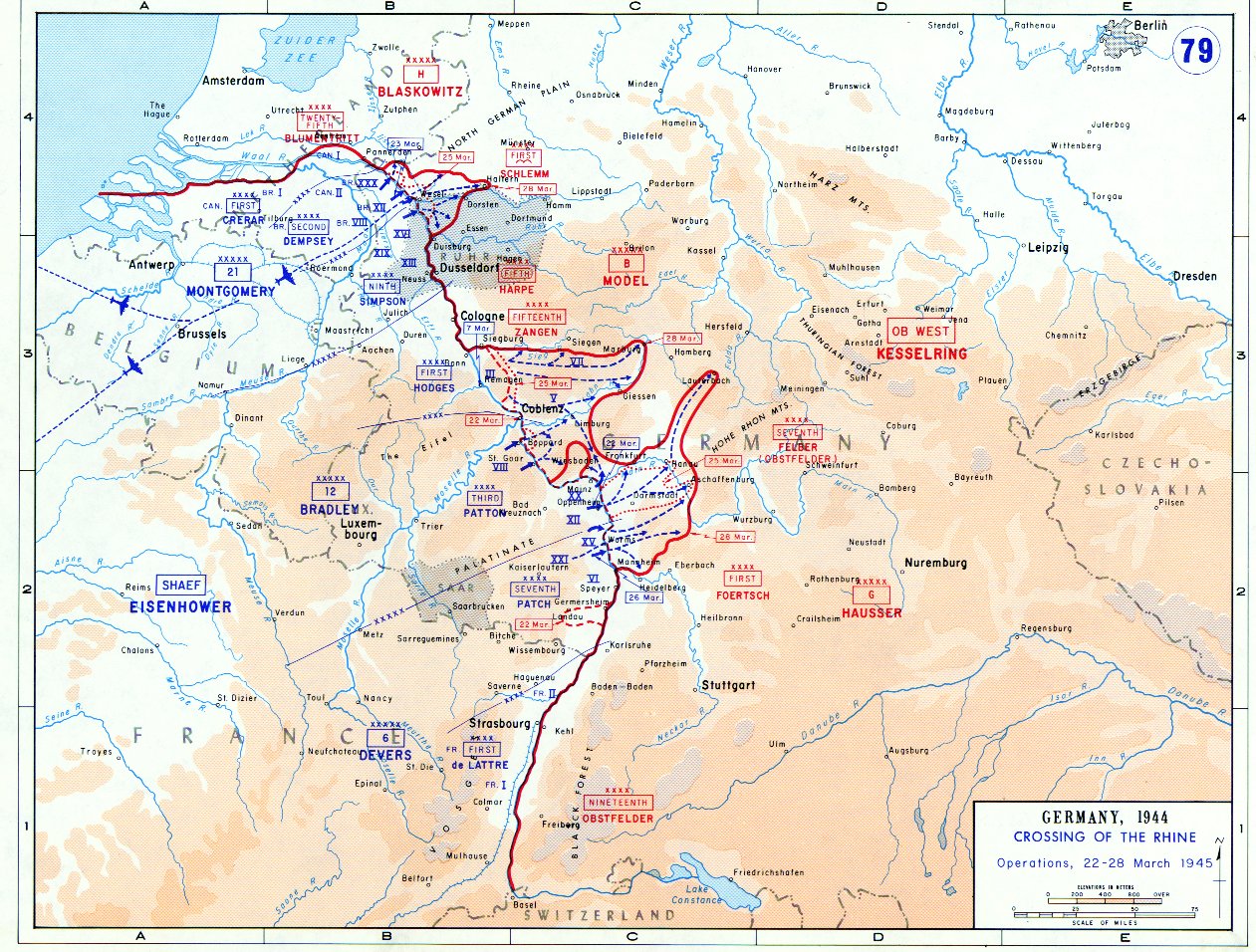
The subsequent Allied advance in April was relentless.
After encircling and capturing over 300,000 German troops in the Ruhr Pocket, Bradley’s armies drove deep into Germany. Hodges’ 1st Army pushed towards Leipzig and the Elbe River, while General William Simpson’s 9th Army advanced on Magdeburg, with Simpson still holding out hope that he might be unleashed towards Berlin. To the south, Patton’s 3rd Army raced towards Chemnitz before wheeling southeast into Austria, its advance uncovering both the unspeakable horror of the Ohrdruf concentration camp and the hidden German national treasure in a salt mine at Merkers. In the far north, Montgomery’s 21st Army Group also made rapid progress, liberating the Netherlands, capturing key ports like Bremen and Hamburg, and reaching the Baltic coast at Wismar, effectively sealing off German forces in Denmark.
By mid-April, American spearheads were on the Elbe and Mulde rivers.
Berlin was tantalizingly close, perhaps only a three-day push for Montgomery’s or Simpson’s armored columns. Churchill, sensing a final opportunity to gain a crucial postwar bargaining chip, passionately urged Eisenhower to take the city.
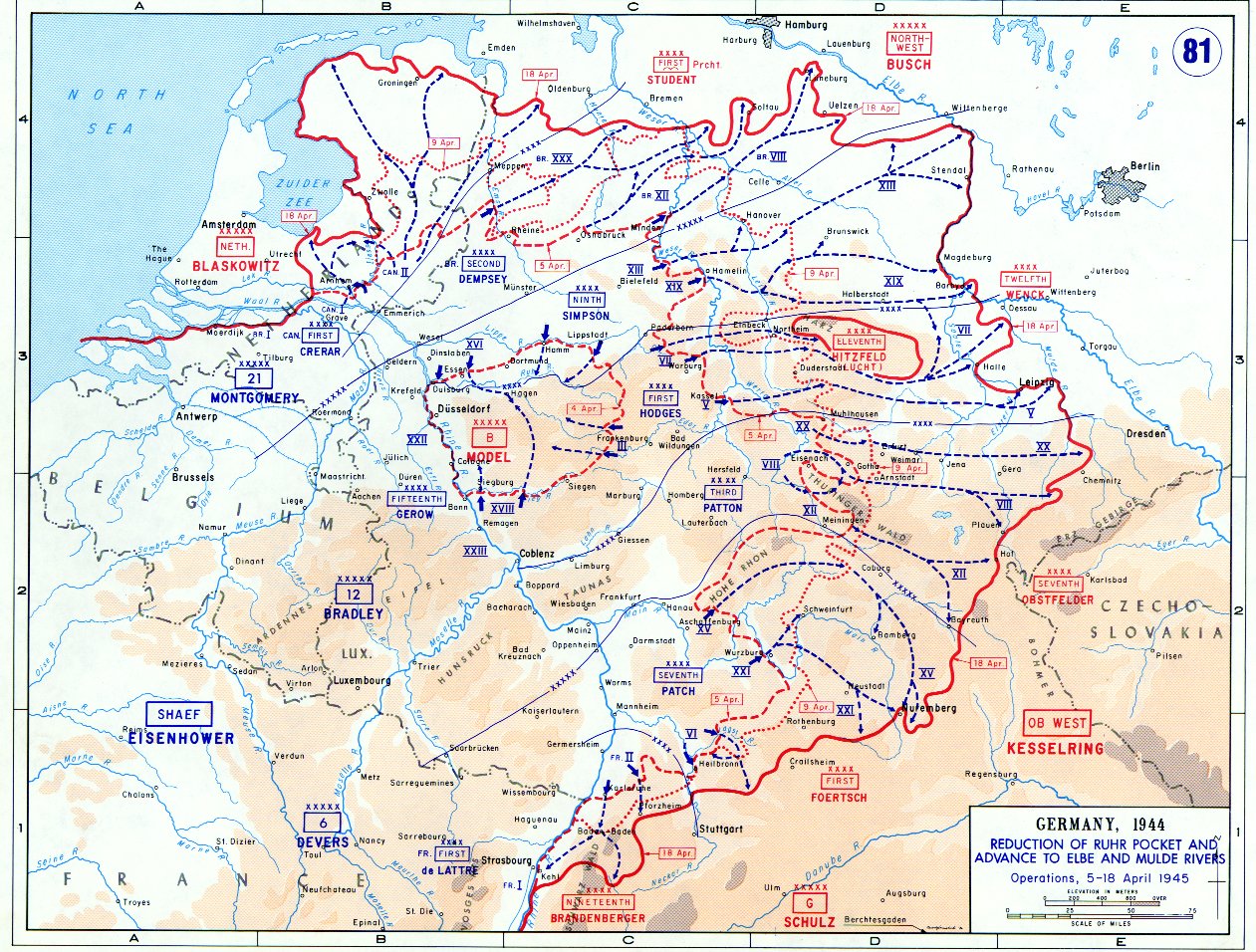
Even Patton, no admirer of Montgomery, agreed that a drive on the capital should be ordered.
Plans for an audacious airborne assault, Operation Eclipse, were even on the books to seize Berlin’s airfields. But Eisenhower, the pragmatic coalition commander, held firm. Bradley had starkly warned that taking a city located deep within the agreed-upon Soviet zone of occupation could cost as many as 100,000 American casualties for a prize of “no military significance.”
On April 15th, the order was given for all armies to halt their eastward advance.
Militarily, the Western Allies possessed the momentum, the resources, and arguably the opportunity to make a credible race for Berlin. Yet, the Supreme Commander’s decision was based on a different set of priorities: the preservation of his soldiers’ lives, the complete annihilation of German military capability, and the elimination of the chimerical Alpine Fortress.
The decision, though rooted in military pragmatism, was also profoundly political, for the lines drawn on the map by advancing armies were already hardening into the frontiers of a new, ideological conflict.
–
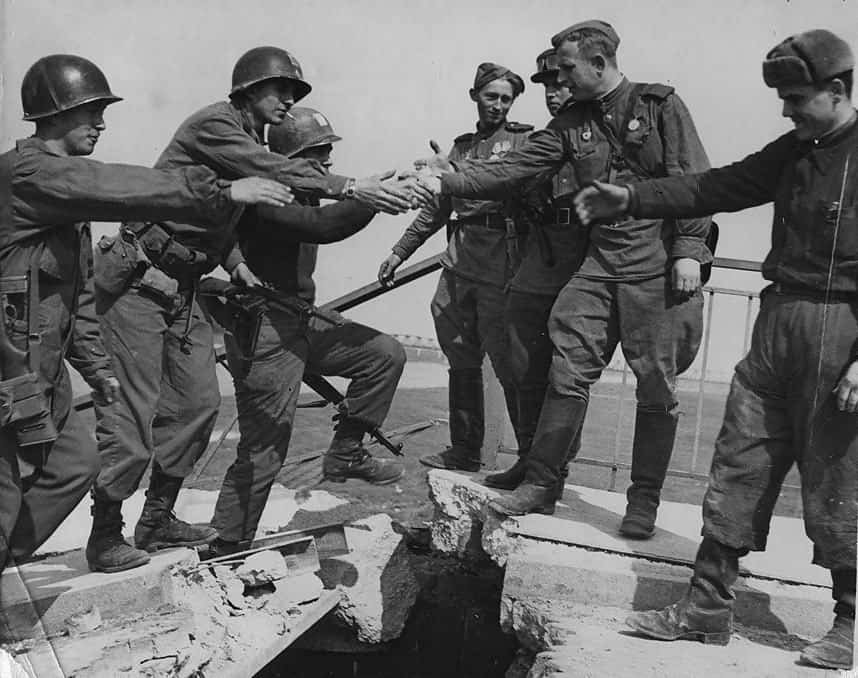
Dissenting Voices & Promises Kept
“Under the agreed plan, the forces of the three powers will each occupy a separate zone of Germany. Coordinated administration and control has been provided for under the plan through a central control commission consisting of the Supreme Commanders of the three powers with headquarters in Berlin.”
Joint Agreement from the Yalta Conference (1945)
The decision by Dwight Eisenhower to halt the Western Allied armies at the Elbe River, while militarily pragmatic, cannot be fully understood without examining the complex political landscape upon which the final act of the Second World War was played.
The choice between a symbolic race for Berlin and a methodical destruction of the remaining German forces in the south was not made in a vacuum in April 1945.
Rather, it was the culmination of high-stakes agreements, competing strategic visions, and a dawning awareness of the post-war world that was already taking shape. While militarily feasible, the ultimate reason the Stars and Stripes or the Union Jack was not raised over the Reichstag is found not in battlefield logistics but in the conference rooms of Yalta and the diverging priorities of the Grand Alliance.

The foundation for Germany’s post-war fate was laid months earlier, at the Yalta Conference in February 1945.
Here, Franklin D. Roosevelt, Winston Churchill, and Joseph Stalin met to hammer out the framework for a defeated Germany and a liberated Europe. A key outcome of this and earlier European Advisory Commission meetings was the formal agreement to partition Germany into zones of occupation.
Crucially, these zones were not to be determined by the final positions of the conquering armies, but were drawn along historical German administrative lines. Under this pre-arranged map, the city of Berlin—though it would also be divided into sectors for each of the major Allied powers—fell unequivocally deep inside the territory designated as the Soviet zone of occupation, approximately 150km from the border of the intended British and American zones.

This single geopolitical fact was the bedrock of Eisenhower’s military reasoning.
From his perspective as Supreme Allied Commander, launching an assault on Berlin would mean sacrificing thousands, perhaps tens of thousands, of American and British lives to capture a city that, by prior international agreement, they would be required to hand over large parts of to the Soviets almost immediately.
General Omar Bradley’s stark estimate, warning that the capture of Berlin could cost 100,000 casualties, provided a powerful humanitarian and military justification.
As the Red Army closed in on the city, preparing for a final, brutal showdown, Eisenhower saw no sense in a race for a prize that was already politically forfeit. What, he reasoned, was to be gained by overrunning territory that had already been promised to the Soviets? The Supreme Allied Commander was not about to risk a confrontation with a vital, if increasingly distrusted, ally and potentially start World War Three by occupying territory assigned to them.

This pragmatic, military-first viewpoint, however, was not universally shared.
A powerful and persistent dissenting voice came from across the Atlantic: British Prime Minister Winston Churchill. With a historian’s long view and a statesman’s deep suspicion of Stalin’s intentions, Churchill saw the final military operations of the war through a starkly political lens.
As early as the spring of 1945, he was looking past the defeat of Nazi Germany to the looming threat of a “Soviet-dominated” Europe. For Churchill, the Red Army was not merely a partner in victory but also a potential adversary in the peace that would follow. He believed that the Western Allies should seize as much central European territory as possible to create a stronger bargaining position with Stalin in the post-war settlement.

In a series of increasingly urgent telegrams to Roosevelt and Eisenhower, Churchill argued passionately for a push to Berlin.
He wrote, “If the Russians also take Berlin, will not their impression that they have been the overwhelming contributor to our common victory be unduly imprinted in their minds, and may this not lead them into a mood which will raise grave and formidable difficulties in the future?” He saw the capture of Berlin not as a mere symbolic victory, but as a crucial strategic and psychological check on Soviet ambition. The presence of Western troops in the German capital, he believed, would fundamentally alter the dynamics of post-war negotiations.
Churchill was not entirely alone in this sentiment.
Within the Allied military command, there were those who chafed at the order to halt. General George S. Patton, whose 3rd Army had been a thunderbolt across France and Germany, was famously anti-Soviet and would have relished the opportunity to take Berlin. More concretely, General William H. Simpson, commander of the U.S. 9th Army, had reached the Elbe on April 11th and established a bridgehead the following day. His forces were the closest of all Western armies to Berlin, just 60 miles away, and he believed he could be in the capital within 48 hours. He repeatedly requested permission from Bradley to advance, only to be denied. For commanders like Simpson, the order to stop within sight of the ultimate objective was a source of immense professional frustration.

The decision to formally abandon the race for Berlin was communicated directly by Eisenhower to Stalin on March 28th 1945.
In this message, Eisenhower outlined his plan for a main thrust through central Germany to meet the Red Army near the Elbe, explicitly stating that he considered Berlin to be a secondary objective. This communication effectively signaled to the Soviets that the Western Allies would not contest their capture of the city. While Eisenhower presented this as the soundest military strategy to end the war quickly—which it arguably was—it also served as a de facto reaffirmation of the Yalta agreements. The decision was therefore not made in the heat of battle in mid-April, but was rather a confirmation of a political reality that had been established months before.

Ultimately, the choice to cede Berlin was a fundamentally political one, executed through the lens of a pragmatic military commander. Eisenhower’s primary duty, as he saw it, was to his soldiers and to the swift conclusion of hostilities against Germany. He was unwilling to trade American lives for a political objective he believed was both temporary and in violation of standing agreements. Churchill, the politician, was playing a longer game, one of geopolitical chess where the fall of Berlin was a critical move in shaping the future of Europe.
In the end, the American view, backed by the immense weight of U.S. military and economic power, prevailed.
The halt on the Elbe became not merely the end of a military campaign; but the demarcation line of a new, divided continent, where promises kept in the heat of war would soon be tested by the chill of an emerging Cold War.
–
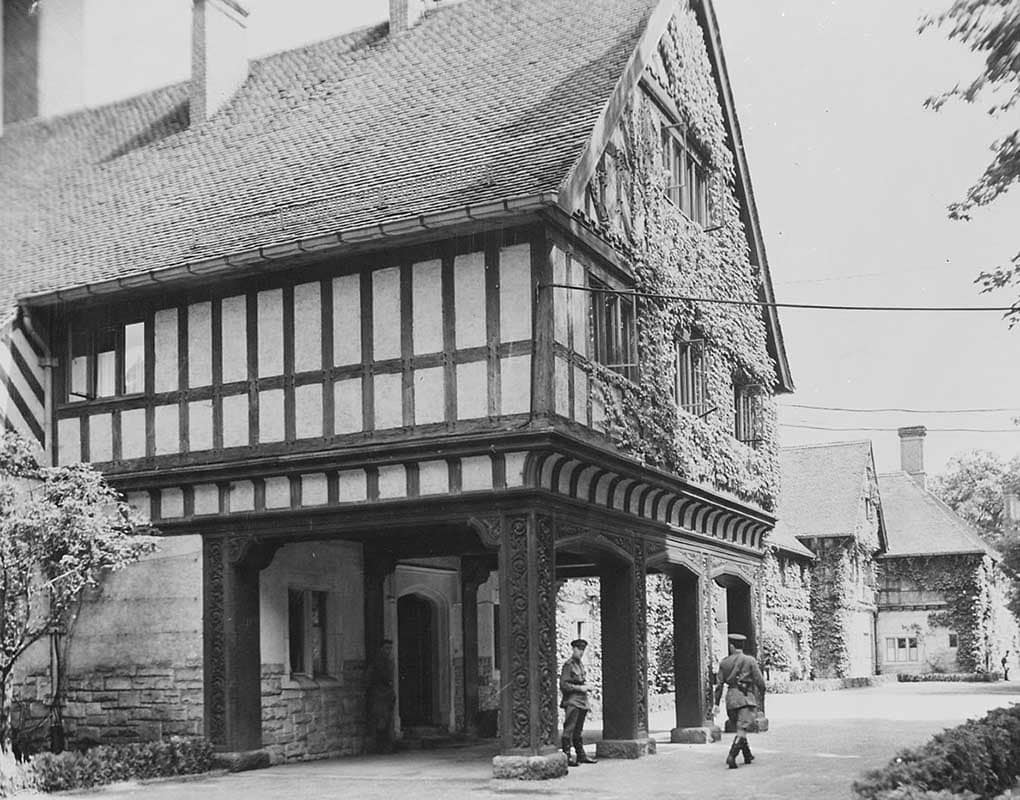
The Fallout - Quae Churchill praedīxerat
“Fig leaves of democratic procedure to hide the nakedness of Stalinist dictatorship”
US diplomat, George Kennan, describing the situation in post-war Eastern Europe (1986)
In the shadow of total victory in Europe, the leaders of the Anti-Hitler Coalition met in the summer of 1945 to finalise the fate of a vanquished Germany and redraw the map of Europe.
The conference’s official name was, and remains, ‘The Berlin Conference’, a title imbued with the symbolic weight of having been held in the enemy’s capital. Yet, this was a symbolic act the Allies could not fulfill.
The city of Berlin was a wasteland of rubble and ghosts, so utterly devastated by the final, brutal battle that it was unfit even to host the victors. Instead, the Soviets, as masters of the territory, directed the proceedings to the largely undamaged Cecilienhof Palace in the nearby city of Potsdam.

This simple change of venue was a potent, unspoken declaration of the new reality on the ground: while the Western Allies would have a seat at the table, it was the Soviets who owned the house. The agreements made at Potsdam would largely ratify the zonal divisions established at Yalta, but now they were no longer theoretical lines on a map; they were hard frontiers patrolled by the Red Army.
The decision to halt the Western armies at the Elbe had immediate and profound consequences, felt most acutely by the Germans themselves.
In the final weeks of the war, a tidal wave of humanity, both civilian and military, had surged westward. Their single, desperate goal was to escape the advancing Red Army and surrender to the British or Americans. Stories of Soviet brutality on the Eastern Front, both real and exaggerated by Nazi propaganda, had created a deep-seated terror. It is estimated that between one and two million Wehrmacht soldiers scrambled to surrender to the West, often fighting their way through Soviet lines not to continue the war, but to end it on more favorable terms.
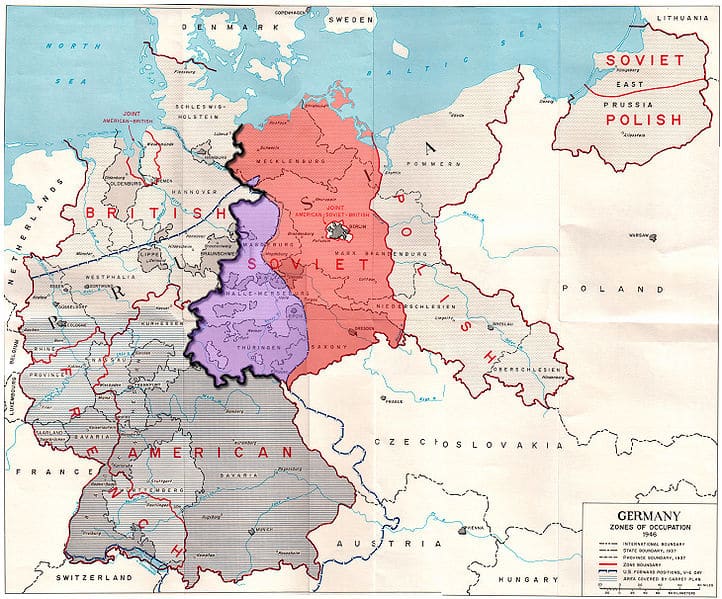
Had the Western Allies pushed on to Berlin, it is almost certain that the entire Berlin garrison, along with hundreds of thousands of troops stationed between the Elbe and the capital, would have laid down their arms to them. While this might not have shortened the war’s official duration by more than a few days, it would have fundamentally altered the post-war landscape, placing the political and administrative heart of Germany into Western hands from the outset.
Instead, as the ink dried on the Potsdam Agreement, the strategic priorities of the Western powers began to shift with dizzying speed.
The United States, perhaps without fully grasping the strength of its own hand, held the ultimate trump card.
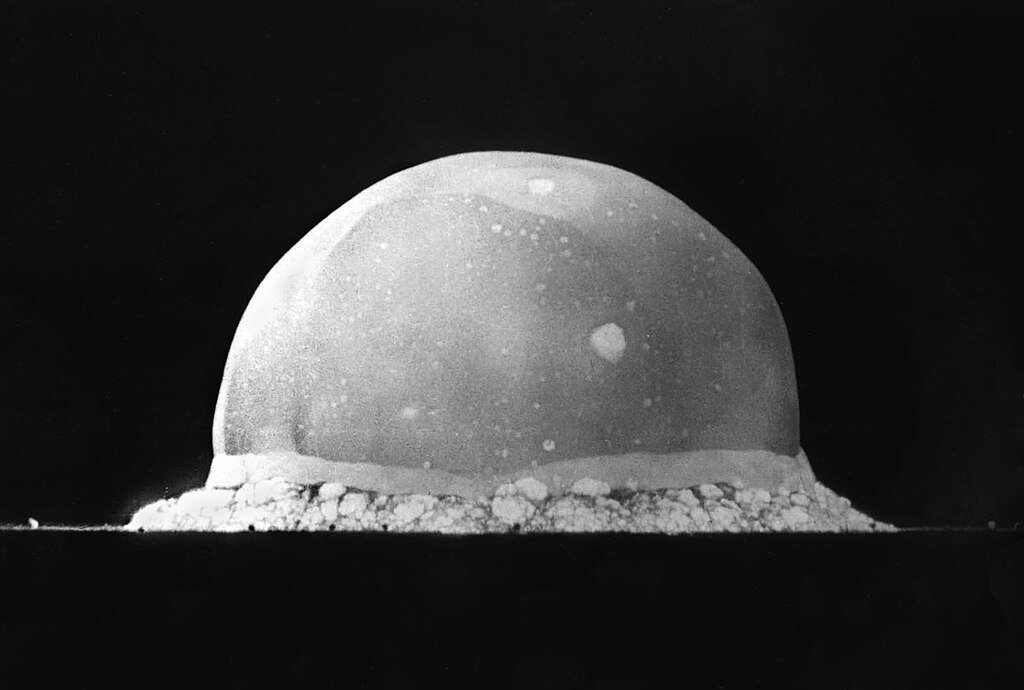
On July 16th 1945, during the conference itself, President Truman received a coded message confirming the successful test of the atomic bomb in the New Mexico desert. For a brief moment in history, America possessed a weapon of unimaginable power with no peer. However, this monopoly was more tenuous than it appeared.
After the two bombs were dropped on Hiroshima and Nagasaki in August, the U.S. arsenal was empty. It would not be until October 1945 that enough fissile material was processed to build more, and even then, the problem of reliable delivery systems remained.
With the Pacific War brought to an abrupt and shocking conclusion, American interest in Europe waned.
The overriding desire was to “bring the boys home,” and the complex political morass of occupied Germany was increasingly seen as a problem to be managed, not solved.
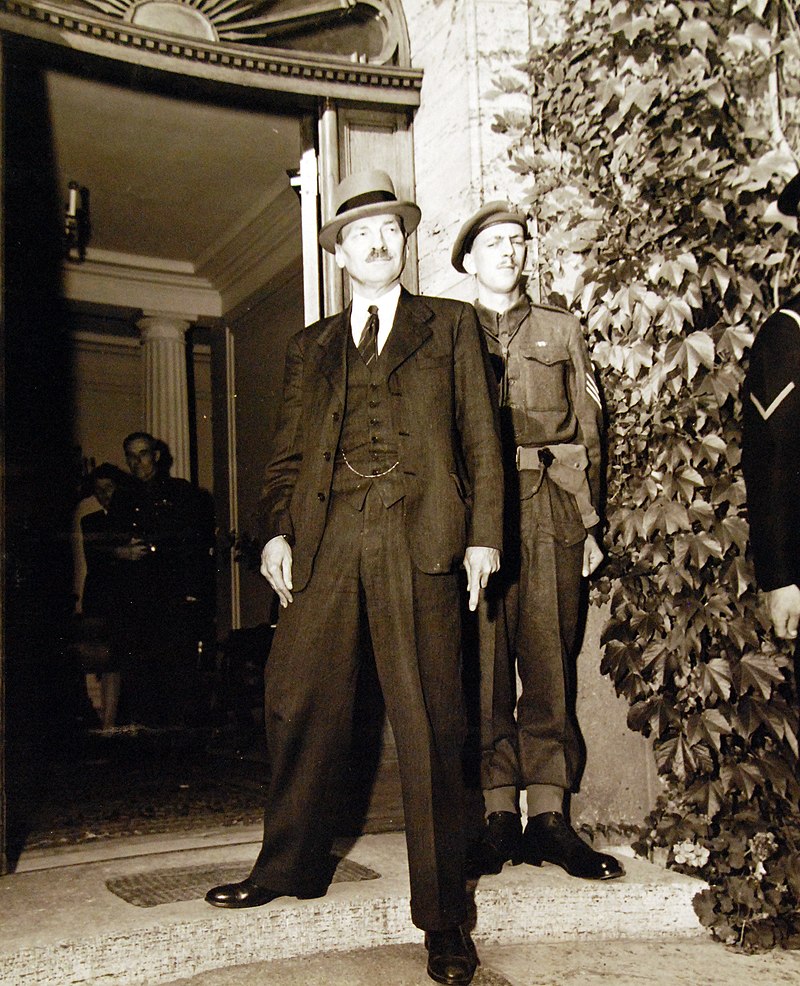
Simultaneously, Great Britain awoke to the grim reality of its own situation.
Victorious but bankrupt, the nation had elected a new Labour government under Clement Attlee, who had replaced Churchill midway through the Potsdam conference.
The new government’s focus was necessarily domestic—rebuilding a shattered economy and creating the National Health Service—and international, in managing the accelerating disintegration of the British Empire. Berlin, a divided island city deep inside the Soviet zone, was reduced to a lingering issue, a matter to be resolved later.
This collective pivot away from central Europe created a power vacuum that a suspicious and expansionist Joseph Stalin was more than willing to fill. The West had done its fair share in helping win the war, but in the crucial first months of peace, it was beginning to lose the continent.
Even as the politicians turned their attention elsewhere, the military planners on both sides were grappling with the terrifying new strategic reality.
The West’s voluntary halt at the Elbe had ceded an enormous conventional advantage to the Soviets, whose massive armies now occupied all of Eastern Europe. The dissenting voice of Churchill, who had feared this exact outcome, found its ultimate expression in a secret document that stands as one of history’s most chilling “what-ifs.”
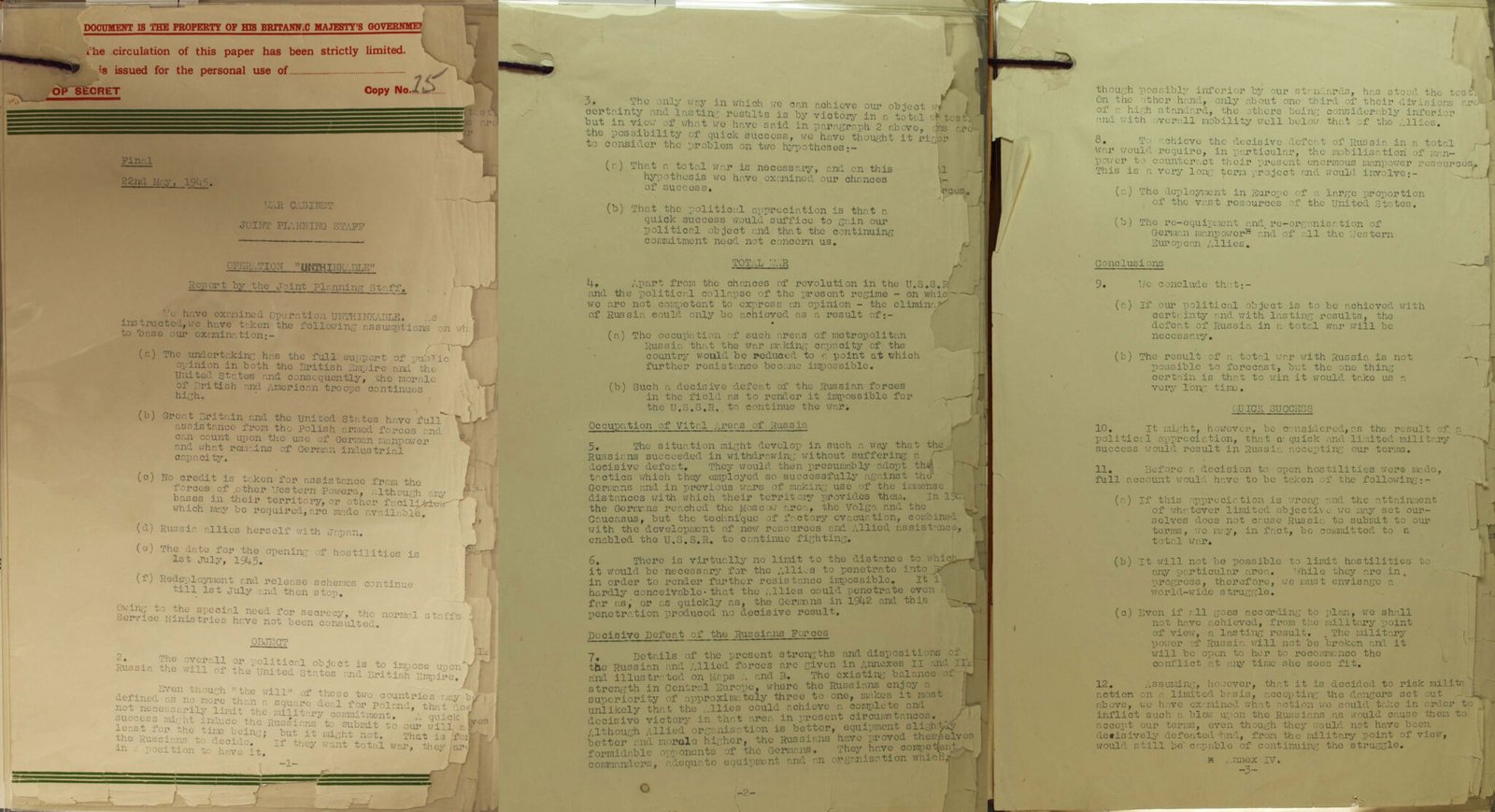
As early as May 1945, Churchill had ordered the British Chiefs of Staff to draw up a contingency plan for a surprise attack on the Soviet Union to enforce the West’s will regarding Poland. The plan, codenamed Operation Unthinkable, was delivered on May 22nd 1945. Its conclusion was stark: a war with the Soviet Union to “impose the will of the United States and the British Empire” was militarily infeasible due to the Red Army’s overwhelming superiority in infantry and armour. The plan was shelved as a worst-case scenario.
Poland – as was shown conclusively at the Potsdam Conference – would be surrendered to the Soviets.
The Americans, however, armed with their new atomic weapon, soon began to think along similar lines.
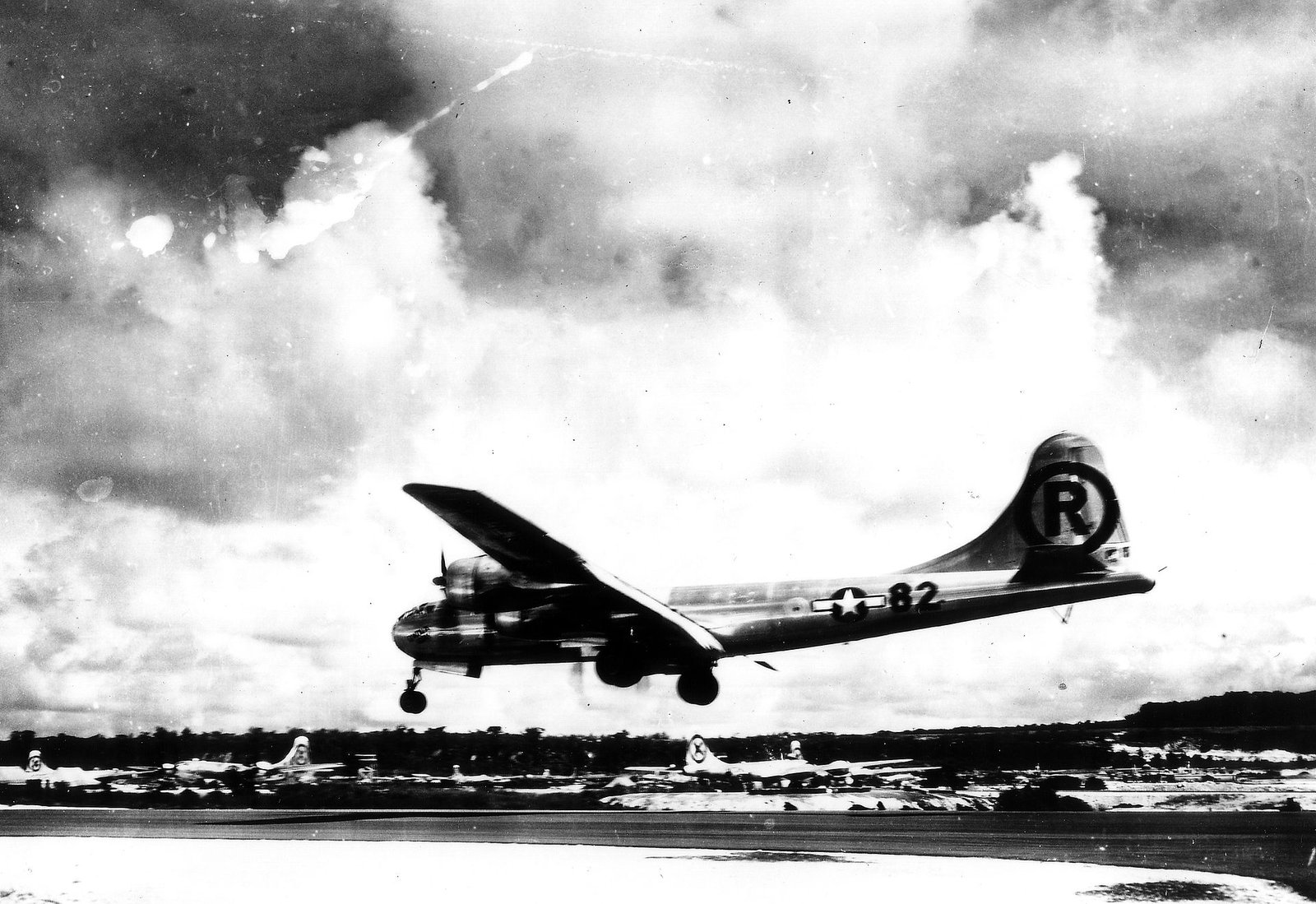
Plan Totality, formulated in 1945, was one of the earliest nuclear war plans, targeting 20 Soviet cities for annihilation in a single, massive first strike. As the Cold War intensified, these nascent plans evolved into far more detailed and terrifying scenarios. Operation Dropshot, conceived in 1949, was a comprehensive outline for a full-scale war with the USSR, projected to start in 1957. It envisioned an onslaught of 300 nuclear bombs—including newer, more powerful models like the Mark 4—and over 250,000 tons of conventional bombs to wipe out 85% of the Soviet Union’s industrial capacity.
These were the secret, horrifying consequences of the political division solidified at Potsdam; the failure to secure a stronger position in 1945 had led directly to planning for a war that would have meant the end of civilisation.
What might have happened differently had the West taken Berlin?
It is the great counterfactual question of the early Cold War.
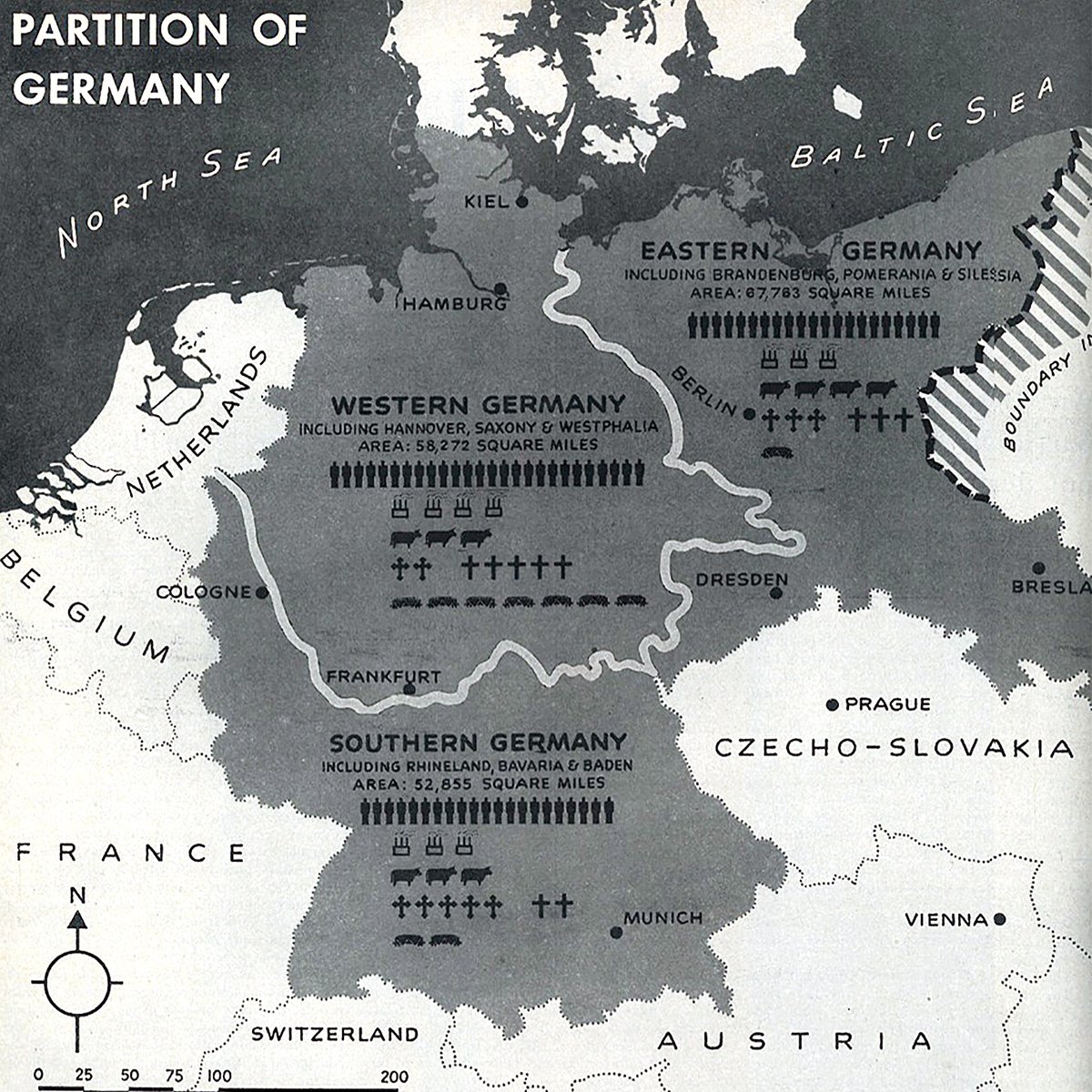
A Western military presence in the capital would not have erased the Yalta agreements, but it would have given the U.S. and Britain immense leverage. The Soviets would have arrived at the negotiating table not as the sole conquerors of the capital, but as partners in a city administered from the start by Western forces. The infrastructure, the records, the symbolic heart of the German state would have been in Allied hands.
This could have profoundly altered the subsequent history of Germany. The Berlin Blockade of 1948 might have been untenable, as the Western powers would have controlled the city’s core from day one. The construction of the Berlin Wall in 1961, an act that physically divided the continent, might have been averted.
The Soviet Union would have been denied its most potent psychological victory—the image of the Red Army soldier hoisting a victory banner over the Reichstag—a symbol they leveraged for forty years as proof of their primary role in defeating Nazism.
The decision to halt at the Elbe, while saving the lives of soldiers in the short term, ultimately locked the West into a reactive and defensive posture for decades.
–

Conclusion
“Montgomery’s operational idea was the best. But all things were not equal. Another, more important limiting factor was politics. Eisenhower was acutely aware that, especially in a presidential election year, the prejudices, preconceptions and attitudes of the American public and political class, not to mention the Army itself, were critical to his continuing command. British views and desires were not without significance, but their confluence was waning as American preponderance and self-confidence grew.”
British military historian C. J. Dick (2016)
YES & NO – The question of whether the Western Allies could have captured Berlin in 1945 is one of history’s most compelling paradoxes, as the answer is a definitive yet contradictory ‘maybe’.
Militarily, the evidence suggests that it was entirely possible.
The momentum of the US and British armies in April 1945, combined with the disintegration of the Wehrmacht, could almost certainly have carried them the final sixty miles.
Commanders like General Simpson were poised and ready, and could have made it to Berlin before the Soviet had managed to overcome the Seelow Heights. Such an action would have answered the desperate hopes of millions of Germans, soldiers, and civilians alike, who risked everything to surrender to the West.
Yet, this purely military capability was constrained by a much harsher and more complex political reality. The decision not to take Berlin was not a failure of will or nerve, but a deliberate choice rooted in the pragmatic calculus of Supreme Allied Commander Dwight D. Eisenhower. Guided by the firm agreements made at Yalta, which had already placed Berlin deep within the future Soviet zone, he saw a race for the city as a strategically pointless sacrifice.
His objective was the swift and total destruction of Nazi Germany’s ability to wage war, not the capture of a symbolic prize already conceded at the negotiating table.
This decision, however, set the stage for the immediate future that Winston Churchill had so presciently feared. His was the dissenting voice, the one that viewed the advancing Allied armies not merely as instruments for ending the Second World War, but as chess pieces in the opening moves of the Cold War. The choice to halt at the Elbe River was, in effect, the West honouring a promise to a partner it no longer trusted.
Ultimately, the capture of Berlin was never a purely military question; it was the first major political question of the post-war world. The decision to forgo it, made to save Allied lives and honour agreements, created the geopolitical fault line that would define the next forty-five years.
In choosing not to race for Berlin, the Western Allies brought one war to a close with professional and disciplined restraint, but in doing so, they also set the stage for the long, tense, and ideological conflict that was to come.
***
If you’ve enjoyed reading this article, consider booking one of our private guided tours of Berlin.
HISTORICAL ARTICLES
Mythbusting Berlin

Are There Any Nazi Statues Left In Berlin? – Mythbusting Berlin
Visitors to Berlin often arrive expecting to find the physical remnants of the tyranny of the 20th century still standing – statues of dictators, triumphal arches, or bronze idols. Instead, they often find none. The stone symbols and statues of the Third Reich are still gazing down on them, however, hiding in plain sight. But why are there no statues of Hitler? Did the Allies destroy them all in 1945, or is the truth stranger
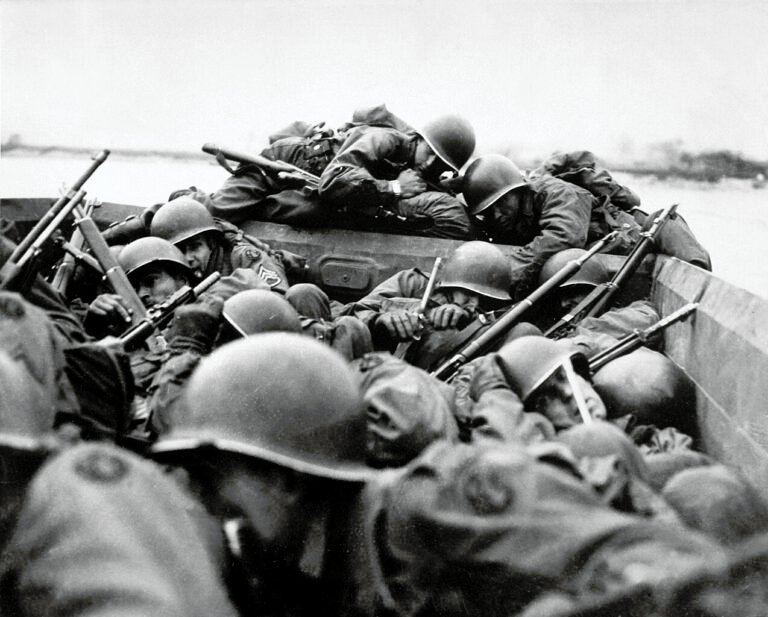
Could The Western Allies Have Captured Berlin? – Mythbusting Berlin
To contemplate a Western Allied capture of Berlin in 1945 is to challenge the established endgame of the Second World War. What was the true military and logistical feasibility of a Western Allied assault on the Nazi capital? What factors truly sealed Berlin’s fate, and what might have changed had the Allies pushed eastward?
Answering these questions means delving into the complex interplay of logistics, political maneuvering, and the competing visions for a post-war world
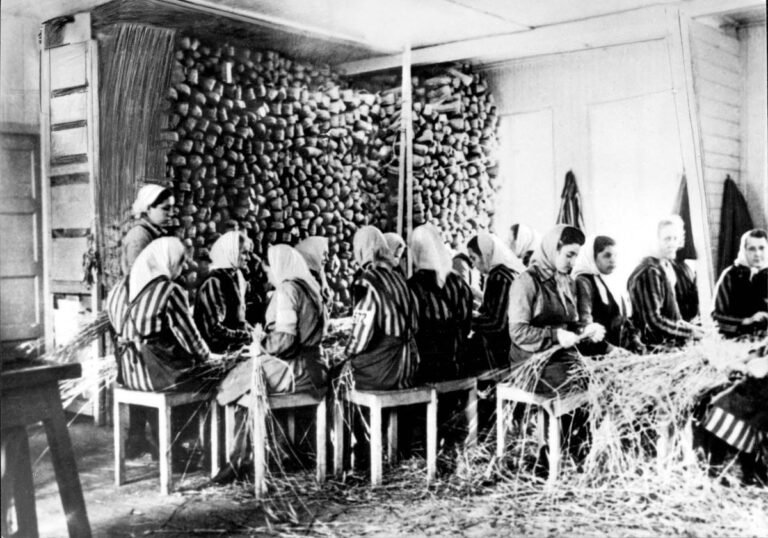
Did Any Of The Rothschild Dynasty Die In The Holocaust? – Mythbusting Berlin
The Rothschild name is synonymous with immense wealth, influence, and persistent conspiracy theories—especially during the era of Nazi Germany. Often targeted by antisemitic propaganda, the family’s survival during World War II has sparked myths about their supposed immunity from Nazi persecution. But did any Rothschild family member actually perish in the Holocaust? This article explores that compelling question, unraveling historical misconceptions and revealing the reality behind one of Europe’s most famous dynasties.
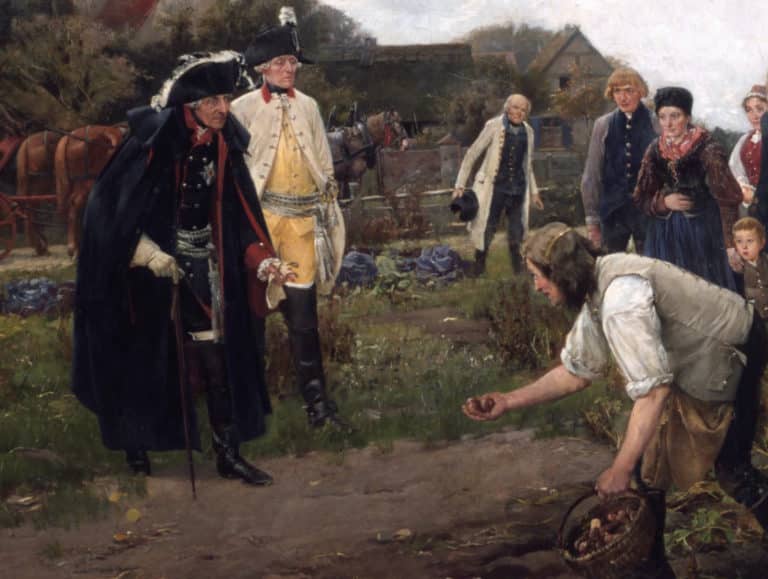
Did Frederick The Great Introduce The Potato To Germany? – Mythbusting Berlin
One of the more bizarre claims to fame attributed to the first King of Prussia is that the man who would go down in history known as Frederick the Great introduced the potato to Germany during his reign back in the 1700s. This starchy root vegetable has undoubtedly become a staple part of German cuisine – an essential addition to any plate of Schnitzel, Schweinshaxn, and Königsberger Klopse – however, whether Frederick the Great is
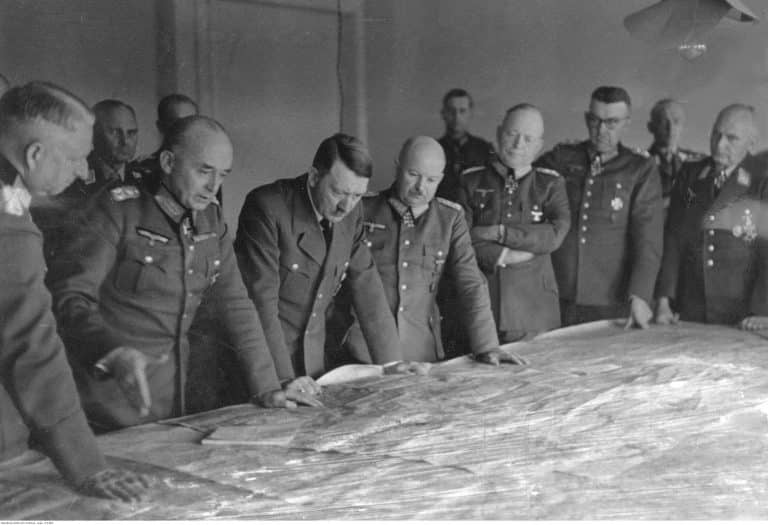
Did Hitler Escape To Argentina In 1945? – Mythbusting Berlin
Although Nazi leader, Adolf Hitler, certainly remains an inescapable figure, could there be any truth to the story of his escape to Argentina in 1945? That the most wanted man on earth could simply vanish, to spend the rest of his life peacefully in South American obscurity captivates imaginations. Yet, despite numerous investigations, this tale persists primarily as myth—fueled by speculation, hearsay, and conspiracy theories.
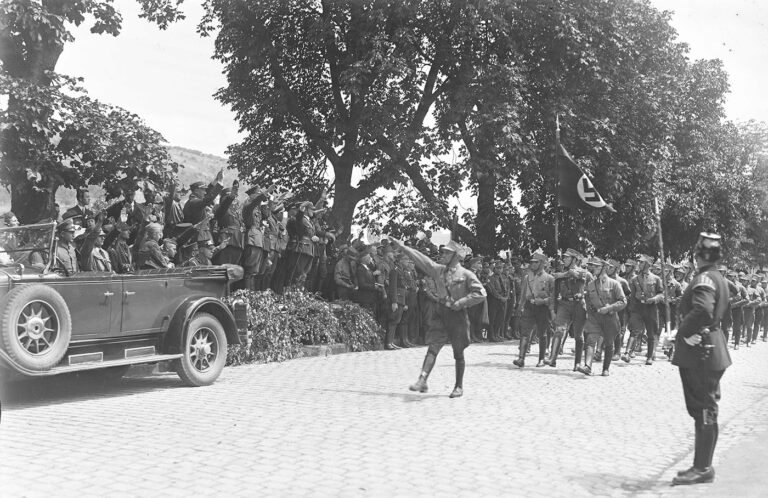
Did Hugo Boss Design The Nazi Uniforms? – Mythbusting Berlin
The idea that Hugo Boss – the man whose name now adorns expensive suits and fragrances – was the creative genius behind the Nazi uniforms suggests a terrifying collision of haute couture and holocaust – a marriage of high style and high crimes. The image is striking: a German tailor sketching the ultimate villain’s costume. But history, as usual, is far messier, more bureaucratic, and more banal than the internet memes suggest. To understand who
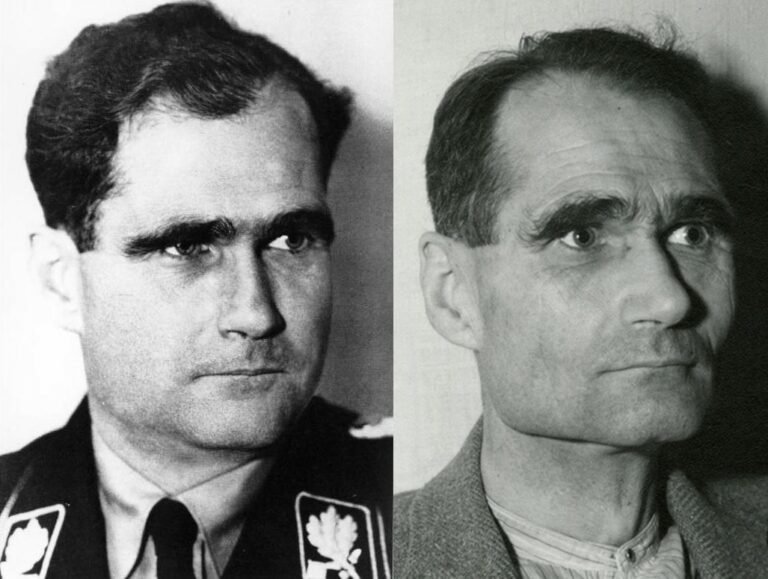
Did Rudolf Hess Really Commit Suicide? – Mythbusting Berlin
On a summer’s day in 1987, the last Nazi war criminal of the Nuremberg trials was found dead in a prison built for hundreds, yet for two decades, housed only him. The official verdict was suicide, a straightforward end to a life defined by fanaticism, delusion, and contradiction.
But the simplicity of the report belied the complexity of the man and the 46 years he had spent in Allied custody. In the meticulously controlled
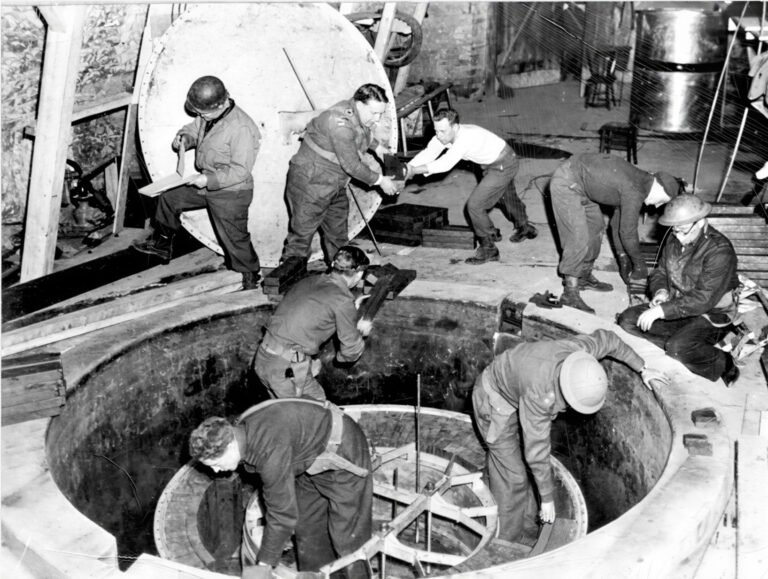
Did The Nazis Develop Nuclear Weapons? – Mythbusting Berlin
The Nazi obsession with super-weapons became so serious in the closing stages of the Second World that Adolf Hitler personally believed that such ‘Wunderwaffen’ both existed in a usable form – and would save the country from defeat. Had the Nazis managed to develop nuclear weapons by 1945 – the outcome of the war would surely have been different. But how close were Hitler, Himmler, and his henchmen to developing an A-bomb?

Did The Nazis Invent Decaf Coffee? – Mythbusting Berlin
Persistent rumors claim that Nazis preferred their coffee anything but pure, leading some to wonder if they might have influenced the development of decaffeinated coffee. Although decaf was already widely available across Europe by the mid-20th century, speculation continues: could the Nazis really have played a role in popularizing—or even discovering—this caffeine-free alternative, or is this simply another caffeinated conspiracy cooked up to sensationalize an ordinary historical detail?

Did The Nazis Invent The Bicycle Reflector? – Mythbusting Berlin
The fruits of wartime ingenuity are plenty – so many, in-fact, that it has become somewhat of a worn cliche that as the guns start firing the innovators get to work, often solving problems while providing more problems for the enemy to overcome.The kind of progress that results in the production of newer improved, more lethal weapons, such as to increase the chances of victory.
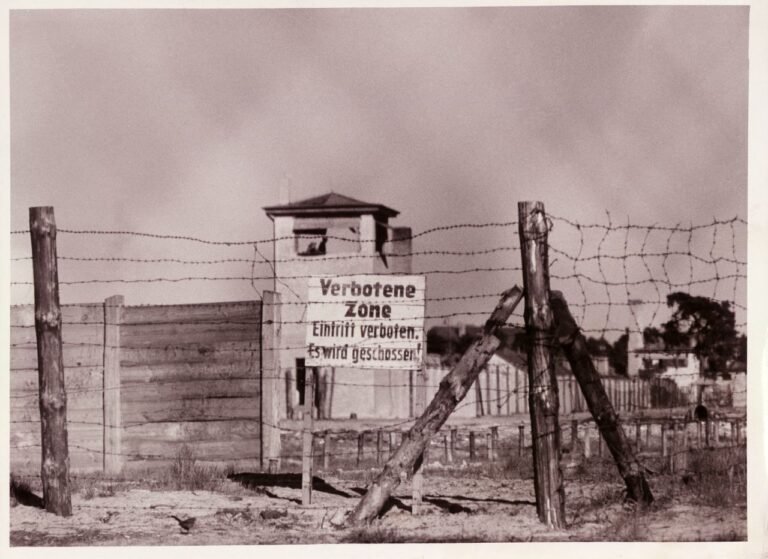
Did The Nazis Run The Largest Counterfeiting Operation In History? – Mythbusting Berlin
During the Second World War the Nazis masterminded an astonishing plot to destabilise Britain by flooding its economy with counterfeit banknotes. Crafted in secret by concentration camp prisoners, this forged fortune became the most ambitious counterfeiting operation ever attempted. But was it history’s largest? Dive into the extraordinary tale of Operation Bernhard,
rife with deception, survival, and intrigue—revealing the truth behind one of the Third Reich’s most audacious schemes and its surprising legacy.
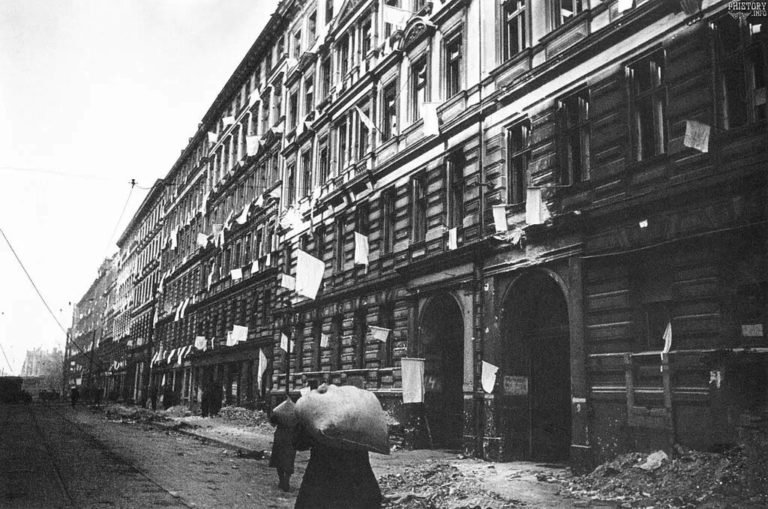
Did The Second World War End In Berlin? – Mythbusting Berlin
When is a war ever truly over? When the last shot is fired in anger would seem like the best measure. Rarely, though, is it possible to gain insight into such a moment.
Remarkably, a record still exists of such a moment at the end of the First World War on the Western Front. A seismic register and recording of the last belching battery of British guns firing artillery across no-man’s-land, followed by a profound
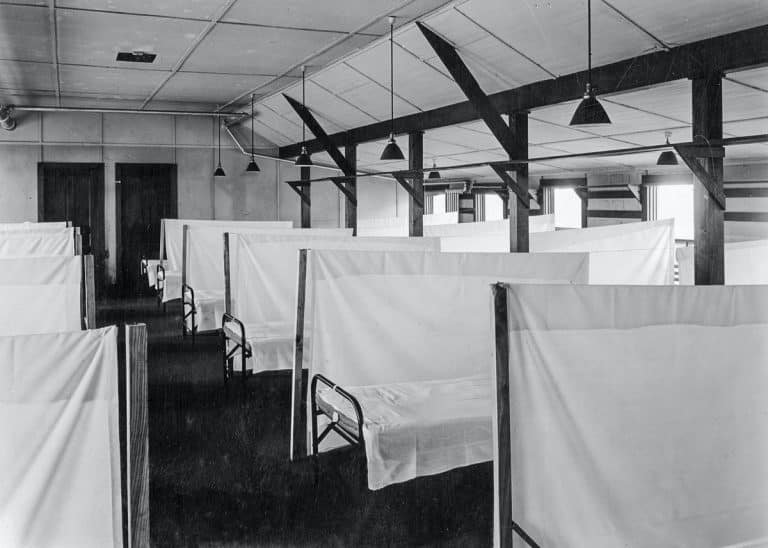
Did The Spanish Flu Pandemic Help The Nazis Take Power? – Mythbusting Berlin
The devastating Spanish Flu pandemic of 1918-1919 struck amid Germany’s post-war turmoil, compounding social instability, economic hardship, and widespread political disillusionment. Could this catastrophic health crisis have indirectly paved the way for Nazi ascension? While often overshadowed by war and revolution, the pandemic’s profound psychological and societal impacts arguably contributed to the perfect storm, enabling extremist ideologies—including Nazism—to gain popularity and ultimately seize power in a fractured Germany.
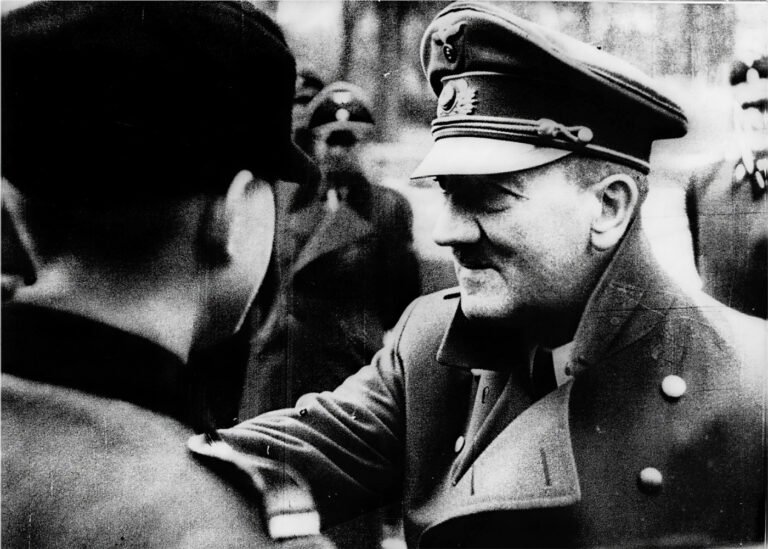
Have Adolf Hitler’s Remains Been DNA Tested? – Mythbusting Berlin
In the smouldering ruins of Berlin in 1945, the world’s most wanted man vanished. Did Adolf Hitler, as official history attests, die by his own hand in the Führerbunker? Or did he escape, fuelling a thousand conspiracy theories that have echoed for decades? For years, the Soviets claimed to hold the gruesome proof of his death: a skull fragment and a set of teeth, locked away in Moscow archives. But in an age of definitive
How Did The Nazi Concentration Camps Differ From The Soviet GULAG?
The Nazi concentration camps and Soviet Gulag system have often been conflated in popular imagination—twin symbols of twentieth-century totalitarian horror. Yet the two systems operated on fundamentally different principles. One extracted labor to fuel industrialisation while accepting mass death as collateral damage; the other evolved into purpose-built machinery of genocide. Understanding these distinctions isn’t merely academic—it reveals how different ideologies produce different atrocities, and why Germany and Russia reckon with these legacies so differently today.

How Long Did It Take To Build The Berlin Wall? – Mythbusting Berlin
It is one of the most enduring images of the 20th century: a city divided overnight. The popular narrative tells us that Berliners went to sleep in a unified city and woke up in a prison. While the shock of August 13th 1961, was very real, the idea that the ‘Wall’ appeared instantly is a historical illusion. The physical scar that bisected Berlin was not a static creation, but a living, malevolent beast that evolved

How Many Assassination Attempts On Adolf Hitler Were There? – Mythbusting Berlin
Nazi leader, Adolf Hitler, projected an aura of invincibility, a man of destiny shielded by providence. But behind the carefully constructed image of the untouchable Führer lies a story of constant threat, of bombs that failed to detonate, and errant bullets that missed their mark. Unearth the hidden history of the numerous attempts on Hitler’s life as we explore the courage of those who tried to change the course of history and the devil’s luck
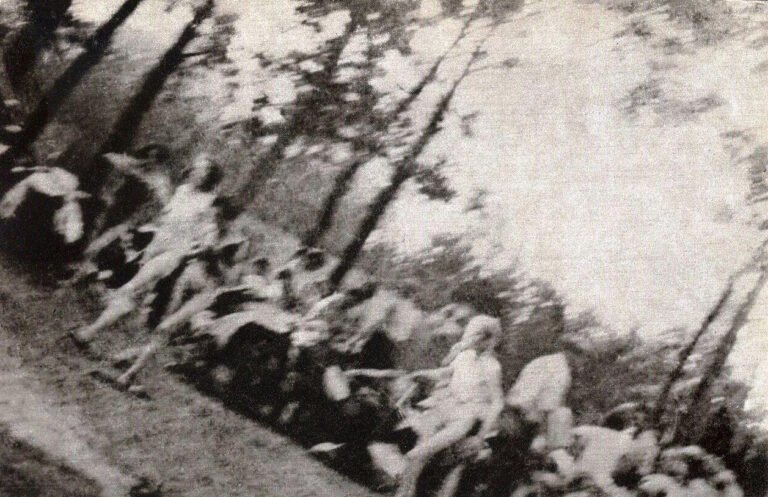
How Many Jews Died In The Holocaust? – Mythbusting Berlin
The answer to the question posed of how many Jews died in the Holocaust is a simple one: too many. That merely one death was an unforgivable obscenity is a fundamental and necessary realisation in understanding the capriciousness of this unparalleled racial genocide. To comprehend, however, the full number of Jews murdered in Europe by the Nazi regime in the 1930s and 1940s is a detective story of epic proportions: the evidence overwhelming, multifaceted, and
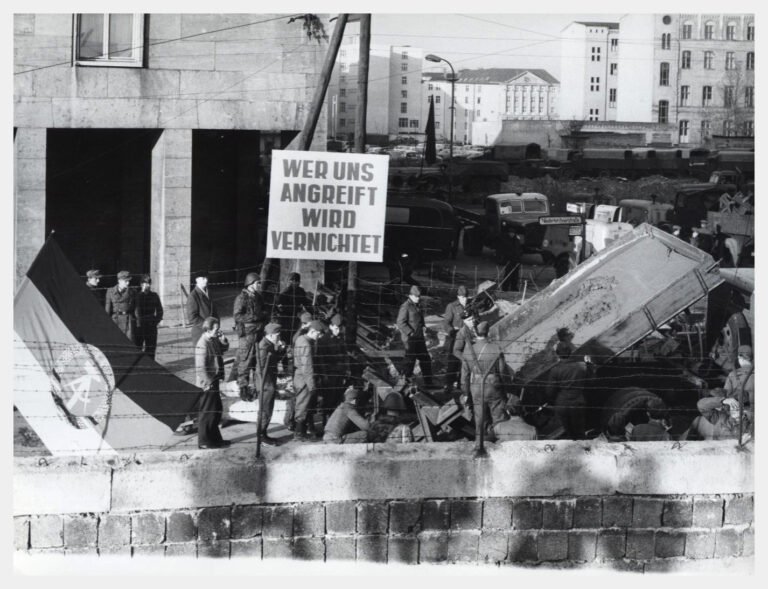
How Many People Died Trying To Escape East Germany? – Mythbusting Berlin
The image of the Berlin Wall is seared into our collective memory, a concrete symbol of Cold War oppression. We think of the daring escapes and the tragic deaths of those who failed. But that well-known number is only a fraction of the truth. The story of those who died trying to escape East Germany is far broader and more complex than most imagine, stretching along a thousand-kilometer border and out into the cold waters
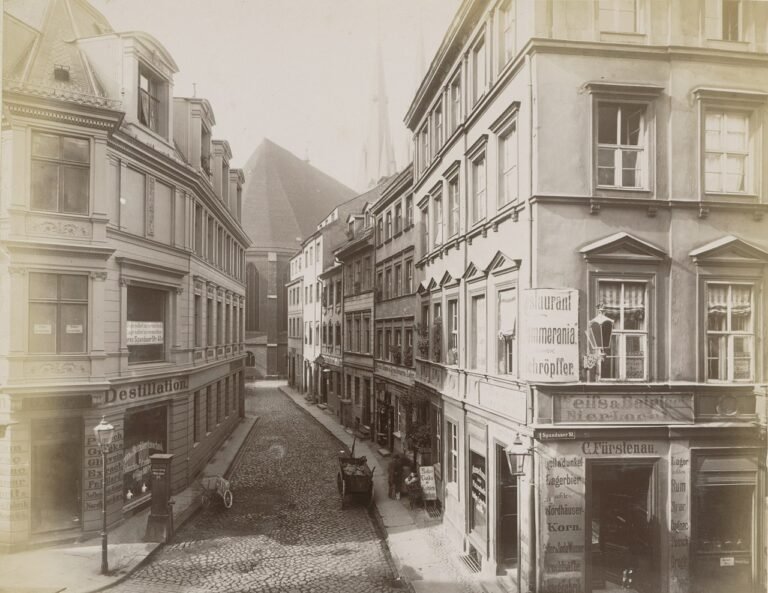
How Old Is Berlin? – Mythbusting Berlin
A relatively new arrival in Europe, Berlin is over 1000 years younger than London, nevermind Rome or Athens, Jerusalem or Jericho. Just how old is Berlin though?
A question fraught with false assumptions and distortions – that has more often than not been answered with propaganda as it has with the cold hard truth.



